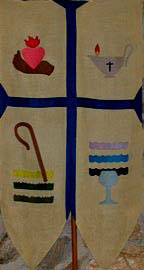 The Heidelberg Catechism
The Heidelberg CatechismHistorical Note
 The Heidelberg Catechism
The Heidelberg Catechism
Historical Note
The Reformation was not a singular movement. Soon after Luther posted his ninety-five theses, reform movements sprang up throughout Europe. As Lutheran thought moved down the Neckar River, Reformed thought traveled up the Rhine from Switzerland. They met at Heidelberg, seat of the oldest university in Germany and capital of the province known as the Palatinate. Tension between Lutherans and Reformed Christians was intense. Because the Reformed did not believe in the real, bodily presence of Christ in the bread and wine, Lutherans believed they were desecrating the Lord's Supper.
Acting to end the controversy, Frederick the Pious, ruler of the Palatinate, asked two young men of Heidelberg--Zacharias Ursinus, professor of theology, and Kaspar Olevianus, preacher to the city--to prepare a catechism acceptable to both sides. Olevianus & Ursinus revised an earlier catechism that Ursinus had written, using its outline and some ninety of its questions and answers. Completed in 1562, the Heidelberg Catechism was published in January of the following year.
 by G. I. Williamson
|
The Heidelberg Catechism opens with two questions concerning our comfort in life and death. The knowledge that our only comfort in Jesus Christ frames the remainder of the catechism. Each of its three parts corresponds to a line of Romans 7:24-25 (NRSV), where Paul cries: "Wretched man that I am; Who will rescue me from this body of death? Thanks be to God through Jesus Christ our Lord;" Thus, questions 3-11 deal with our sin and guilt, questions 12-85 with the way in which God in Jesus Christ frees us, and questions 86-129 with the manner in which we express gratitude to God for redemption.
Each question of the catechism is personal, addressed to "you." Each answer draws as much as possible on biblical language. The catechism's tone is irenic, showing nothing of the controversy that called it forth. Its theology is both catholic, universal in appeal, and evangelical, setting forth the gospel of Jesus Christ. Providing a basis for peaceful coexistence between Lutheran and Reformed Christians, the catechism denied that the bread and wine become the very body and blood of Christ but affirmed that "by this visible sign and pledge . . . we come to share in his true body and blood through the working of the Holy Spirit . . . ." (Paragraph 4.079)
The influence of the Heidelberg Catechism in the church's preaching and teaching continues to be felt in Germany, Austria, Holland, Hungary, parts of Eastern Europe, Scotland, Canada, and the United States.